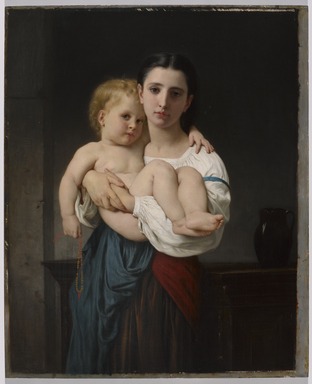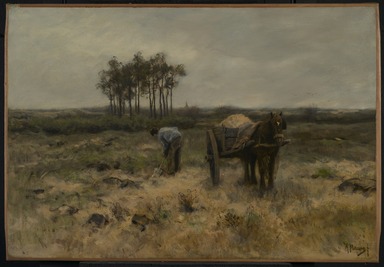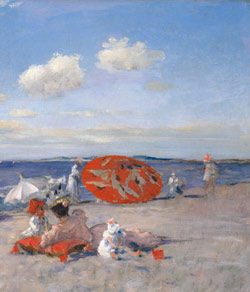 Loading...
Loading...
Final Project: The Importance of Realism
 Loading...
Loading...
 Loading...
Loading...
Dr. Beth Gersh-Nesic, “A beginner’s guide to Realism,” in Smarthistory, August 9, 2015, accessed December 5, 2018, https://smarthistory.org/a-beginners-guide-to-realism/.
This online source talks about how realism came to be. The modern era began and people believed that art should also become modernized. Modern life is about social mixing and social mobility and people believed that art should reflect this. This all began in Paris. A man named Gustave Courbet came to Paris and met with Baudelaire and other progressive thinkers and declared himself as the leader of a new art movement called realism. He said that realism should be about the history of real life and that it should have a social consciousness.
Finocchio, Ross. “Nineteenth-Century French Realism.” In Heilbrunn Timeline of Art History. New York: The Metropolitan Museum of Art, 2000–. http://www.metmuseum.org/toah/hd/rlsm/hd_rlsm.htm (October 2004)
This online source talks about the realist movement in France. The movement flourished in the 1860s and continued to the late 19th century. The purpose of the realist movement was to convey a truthful and objective vision of contemporary life. Realism rose in the outcome of the Revolution of 1848 that toppled the government of Louis-Philippe and created amid the time of the Second Empire under Napoleon III. As French society battled for vote based change, the realists democratized workmanship by portraying current subjects drawn from the regular daily existences of the common laborers. Rejecting the ideas of neoclassicism and romanticism, realism is based on observation of the modern world.
Rabinow, Rebecca. “Édouard Manet (1832–1883).” In Heilbrunn Timeline of Art History. New York: The Metropolitan Museum of Art, 2000–. http://www.metmuseum.org/toah/hd/mane/hd_mane.htm (October 2004)
This online source talks about one of the most famous artists during the realism movement. Eduard Manet has contributed a lot to the realism movement and went through a lot of criticism to become a well-known artist. Manet’s work was rejected many times and when the public saw his paintings, they were shocked and attacked Manet. One of his most famous works, Olympia, also received a lot of criticism. It took about seventy years for one of his works to be presented at the Louvre. To this day, Manet is still considered by many art historians to be the father of modernism.
Ed. Donna Campbell. “Realism (late 1800s-early 1900s).” Scholastic.com. Web. 06 Dec. 2018. http://www.scholastic.com/browse/article.jsp?id=3753924
This article talks about realism in both literature and art. Realism was created as a reaction against romanticism. Pretty much every work of writing has some level of realism. This is on the grounds that it is critical for perusers to perceive and relate to the characters and the world they occupy. In any case, realism as an unmistakable style and scholarly development go back to France in the mid-1800s. The realist movement in art started in France amid the 1800s. The realists needed to split far from the formal masterful styles and subjects of the past. Their works normally depicted standard, or average workers, individuals, instead of chivalrous, notable, scriptural, or illustrious figures. They additionally delineated scenes of customary life, for example, country scenes with agriculturists grouping bulls or gathering grain. The realists looked to respect what they felt was the honorable poise of humble individuals having basic existences.
Griffin, Randall. “A Movement in a Moment: American Realism | Art | Agenda.” Phaidon. Web. 06 Dec. 2018. https://www.phaidon.com/agenda/art/articles/2017/february/23/a-movement-in-a-moment-american-realism/
This article talks about an artist named Winslow Homer and how he applied realism to his subjects in the US. He developed a style called American Realism. Some people did not like Homer’s art and criticized it for being too simple. However, Homer’s work inspired other American artists to also use realism in their artwork. Realism began to get more popular in America.
First off, the Met museum is incredibly huge and I really liked the display of artwork inside. Usually, I get bored of museums but the way the Met is set up and constructed made it hard for me to get bored of it. Another thing I liked is that it makes you feel as if you’re apart of the time period that you’re looking at.
I’m going to be comparing the renaissance artwork, Virgin and Child with Four Angels, and the Baroque artwork, Virgin and Child.
I chose these two because they seemed the most similar in style but they both differ in small ways. First off, the timings of production of both paintings are different. If a painting was made in the 15th to 16th century then it was a renaissance artwork. If a painting is made during the late 16th to 17th century then it was a baroque artwork. Both Renaissance and baroque emphasize religion and can put a lot of importance on women. Both artworks I chose is based on a virgin woman. Another difference is that Renaissance artworks did not completely depict human emotion, while Baroque art focused more on showing them.
As you can see, the Virgin and Child with Four Angels painting give more emphasis to religion with the addition of angels while the Virgin and Child painting is more simple and gives importance to the main feature of the painting.
Thesis Statement: Realism, also called naturalism, is the movement where artwork was made based on the quality of representing a person, thing, or situation accurately. It avoids any kind of artificiality and questionable elements. Artworks made during the realism movement serve to show the struggles and lives of people during a specific moment. It shows them in their natural element rather than exaggerated or unnatural.
Artworks:
William Bouguereau, The Elder Sister, reduction, 1864, The Brooklyn Museum.

Anton Mauve, Digging Sand, 1875, The Brooklyn Museum.
Otto Dix, The Businessman Max Roesberg, Dresden, 1922, The Metropolitan Museum of Art.

The topic I’m choosing for the final project is about realism. I’m going to do a paper proposal format. I decided to do realism because I want to see the different ways artists portray this topic. Also, it would be nice to see the background behind why the artist chose to do this specific artwork.
The range of the craftsmanships of the Ancient World go from Ancient Egypt to Ancient Greece, and Ancient Rome, each place has its very own one of a kind arrangement of standards and ways to deal with making workmanship. Old Egyptian workmanship is the canvas, model, design and different expressions delivered by the progress of Ancient Egypt from around 3000 BC to 30 AD. Old Greek craftsmanship emerges among that of other old societies for its improvement of naturalistic yet admired portrayals of the human body, in which to a great extent naked male figures were, for the most part, the focal point of advancement.
The Art of the Ancient World is a to a great degree assorted subfield inside Art itself and highlights numerous one of a kind works of art. Ancient Egyptian craftsmanship included works of art, form in wood, stone and pottery, illustrations on papyrus, faience, adornments, ivories, and other workmanship media. Egyptian craftsmanship was demurely worried about the love to a near faction like a degree of divine beings or lords. This is on the grounds that the subject of existence in the wake of death was essentially pervasive all through ancient Egyptian culture, and was therefore actualized inside the work of art of the old Egyptians. For instance, the divine force of life following death inside ancient Egyptian culture, Anubis, was so conspicuous inside society, that his figure was cut inside headstones of old Egyptian lords and nobles.
Roman craftsmanship alludes to the visual expressions made in Ancient Rome and in the regions of the Roman Empire. Romans worked vigorously in marble and adored Greek workmanship, regularly imitating a considerable lot of the bronzed statues that existed as of now, however in marble. On the ancient Greek and Roman side, notwithstanding, there was a particularly high spotlight on humanism inside the fine arts of these opposite sides of the Art of the Ancient World.
As confirm since the commencement of craftsmanship, there are critical contrasts among the works of art of each of the three masterful times. First is that all works of art be they Ancient Egyptian or Ancient Roman, happened to endeavor a delineation of genuine creatures, dismissing sexual orientation and individual inclinations. Old Egyptian craftsmanship achieved an abnormal state in painting and form and was both very adapted and representative. While Romans and Greeks both concentrated their craft on Humanism these two had a few differences by they way they moved toward this subject. The shared characteristics and contrasts of these old expressions are what helped shape our masterful world both generally and currently, and it is a wonder to perceive what we may keep on advancing workmanship into as people.
Humanism can be defined as being materialistic. It values free inquiry as well as humanity. Humanism focuses on humans and their values, practices, etc. It emphasized human potential is art. It can be looked at as an epistemological shift from ancient art to more “humanistic” art.
I will be comparing the statue of King Menkaure and queen with the statue of Kouros. They are both similar in their pose as they are both rigid and have straight bodies. The Egyptian statue of the king and queen are clothed which shows and focuses on their rank and status. The Kouros statue is nude which gave focus to humanity, beauty, and individuality. Nudity allowed the focus to be on the individual rather than their rank/status. Nudity in Egyptian art showed “shame.” The body on the king and queen was more smooth and idealized whereas Kouros had a more naturalistic body that showed muscle but was also idealized to show that they are youthful and physically fit. Kouros is more anatomically correct and it had geometric patterns in the hair. The Egyptian statue was made to show unchanging eternity whereas Kouros was made to show heroism and a virtuous life.
I chose the artwork called Revolutionary (Angela Davis) by Wadsworth A. Jarrell. It is from 1971 and is a form of contemporary art. There seems to be a lot of historical context behind the painting. The artist, Jarell, co-founded a movement called COBRA, which later went to be called AfriCOBRA, with his wife. Because he is proudly involved in the black rights movement, he dedicated this piece of art to an activist named Angela Y. Davis. Davis fought for racial, gender, and economic justice so Jarell decided to do something based off her and her work. The image is her face with the incorporation of words that Davis herself said and also Black Power slogans.
About the composition of the painting, the colors incorporated in the artwork is very important. The color scheme is made up of mostly of warm colors. There are reds, pinks, purples, and yellows all involved. They are also important because they are the AfriCOBRA’s signature colors. It was blended in a way where all the colors can just pop up at you. Also, the words are written with the same colors so it blends in but it was done so interestingly that you can still read out the words on the painting. The painting is on a canvas made with acrylic and mixed media. The scale of the painting is very big, you can compare it to the size of an adult bike.
Something very interesting about the artwork is that Angela is seen wearing a belt of bullets. These belts were extremely popular symbols of revolutionary thought. This shows Jarell’s dedication into depicting the reality and truth about the black rights movement.
I chose the artwork called Funerary Stela of Intef and Senettekh and is a classical Egyptian art piece. The first part of the analysis I want to get into is the historical context of the work. It was made during 2065-2000 B.C.E. It is a stela from the tomb of Intef and his wife, Senettekh. It was more common this way to memorialize their family. Next, we can look at the context of the work, as in what is happening in the artwork. The work shows Intef and Senettekh sitting together with their dog underneath them. They are being offered a huge amount of food. You can see a variety of offerings from bread and vegetables to an actual head and leg of animals. The wife and husband are sitting together but you can see that the husband is sitting in a higher position and is in front of her rather than next to her. Also, the wife looks like she is giving a back massage to the husband. This can show that Intef and his wife are not equal as human beings and he has more power than her. Also, they are both barefoot which could be seen as them being royals or of importance.
Another form of analysis we can use is the composition of the work. The artwork is made of Limestone. Limestone were the main building stones used in ancient Egypt. This shows that this artwork was important as one of the most important stones were used to make it. It can also be that it was collected from the remains of a pyramid after it was destroyed or something. There is no color in the work, everything was carved. Also, the lines look very meticulous but also not too straight where it would not look natural. The scale of the work is not big, you can compare it to the size of a coffee cup.
Unit 1 was about the pedagogy and power, banking model, and formal analysis. The Banking Model is described as teachers simply passing on an idea to the students. The teachers talk and lecture while the students are quiet and receive the information. I have experienced this type of model many times in high school. Some teachers I had would not care to listen to anything the students had to say. They would think everything that they said was correct. I think this model has more negative aspects rather than positive. You might be able to learn something but it’s not the most effective and long-term method of teaching. I think its very important for teachers to engage and encourage their students to speak up in class. This helps a lot of students learn better. The pedagogical approach to any subject must be important when you want someone to learn. For example, if you’re teaching drawing you shouldn’t just put a fruits basket in front of the students and expect them to know how to draw. You would have to teach them the basics first.
Another thing we learned is formal analysis. Formal analysis is not only describing the art but also showing and understanding what the artist is trying to convey, visually. Everybody has different ways of looking at things so our own interpretation of art will have a play in what we think it means. When focusing on formal analysis, there are some characteristics we use: color, line, space and mass, scale. We also look at the composition of the art. Composition means how the artist combines all these factors in their work of art. We also use the historical context of an artwork. It relates to the things that happen during the time the art was made. It serves to give us a better understanding of the art and show why the artist decided to make this artwork.
It’s very interesting that you can learn so much about an artwork from its historical background. I never knew how to analyze an artwork before but after learning some basics on formal analysis it has become easier. When looking at the Titian Venus of Urbino, I noticed that a lot of warmer colors were used as opposed to cool or neutral colors. Colors like pink and red were used a lot. Another technique that was cool was looking at the way the artist catches your eye from the direction of lines. They guide your eyes intentionally from left to right. I personally thought that was interesting and cool how an artist can make you do that. Also, learning of the historical background of the painting really put it into a perspective of why the art was made.